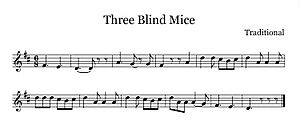Three Blind Mice facts for kids
Quick facts for kids "Three Blind Mice" |
|
|---|---|

Sheet music
|
|
| Nursery rhyme | |
| Written | Thomas Ravenscroft |
| Published | c. 1609 |
| Songwriter(s) | Unknown |
"Three Blind Mice" is a very old and famous English nursery rhyme and a musical round. A "round" is a type of song where different groups of singers sing the same melody but start at different times, creating a layered sound. This rhyme is known all over the world! It has a special number, 3753, in the Roud Folk Song Index, which helps keep track of traditional songs.
Contents
The Rhyme's Words
The words we usually sing today are:
- Three blind mice. Three blind mice.
- See how they run. See how they run.
- They all ran after the farmer's wife,
- Who cut off their tails with a carving knife,
- Did you ever see such a sight in your life,
- As three blind mice?
This rhyme tells a short, funny (but a bit scary!) story about three mice and a farmer's wife.
Musical Connections and Fun Facts
The tune of "Three Blind Mice" has been used by many musicians over the years. It's a simple tune, which makes it easy to recognize and use in different ways.
Classical Music and the Mice
- A long time ago, in 1843, a musician named Thomas Oliphant noticed that a part of a song by a composer named Weiss sounded just like the notes for "Three Blind Mice."
- The famous composer Joseph Haydn used the tune in one of his big orchestral pieces, his Symphony 83, which is also called La Poule (The Hen).
- Another composer, Havergal Brian, even wrote a whole orchestral piece called "Fantastic Variations on an Old Rhyme" based on the tune. He imagined it as part of a funny symphony about the nursery rhyme!
Modern Uses of the Tune
- You might have heard the "Three Blind Mice" tune as the theme song for The Three Stooges, a famous comedy group.
- The line "See how they run" was used in the song "Lady Madonna" by The Beatles.
- For the James Bond movie Dr. No, a calypso version of the tune was created with new words.
- The children's TV show Sesame Street even made their own version of the song, changing it to "B is for Bubble."
The "Complete Version" Story
In 1904, a children's book by John W. Ivimey was published called The Complete Version of Ye Three Blind Mice. This book made the mice into characters who went on adventures.
- In this longer story, the mice become blind after running into a thorny bush.
- Later, their tails are cut off by "the butcher's wife," which is a bit different from the original rhyme that mentions the farmer's wife.
- But don't worry! The story has a happy ending. The mice use a special tonic to grow new tails and get their eyesight back. They even learn a job, buy a house, and live happily ever after!
This book is now in the public domain, which means anyone can share and use it freely.

